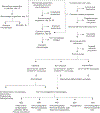The Phylogeny, Ontogeny, and Organ-specific Differentiation of Macrophages in the Developing Intestine
- PMID: 36698382
- PMCID: PMC9872774
- DOI: 10.5005/jp-journals-11002-0044
The Phylogeny, Ontogeny, and Organ-specific Differentiation of Macrophages in the Developing Intestine
Abstract
Macrophages are large highly motile phagocytic leukocytes that appear early during embryonic development and have been conserved during evolution. The developmental roles of macrophages were first described nearly a century ago, at about the time these cells were being identified as central effectors in phagocytosis and elimination of microbes. Since then, we have made considerable progress in understanding the development of various subsets of macrophages and the diverse roles these cells play in both physiology and disease. This article reviews the phylogeny and the ontogeny of macrophages with a particular focus on the gastrointestinal tract, and the role of these mucosal macrophages in immune surveillance, innate immunity, homeostasis, tissue remodeling, angiogenesis, and repair of damaged tissues. We also discuss the importance of these macrophages in the inflammatory changes in neonatal necrotizing enterocolitis (NEC). This article presents a combination of our own peer-reviewed clinical and preclinical studies, with an extensive review of the literature using the databases PubMed, EMBASE, and Scopus.
Keywords: Blood counts; Inflammation; Macrophages; Monocytes; Organ injury; Signaling.
Conflict of interest statement
Conflict of interest: None
Figures





Similar articles
-
Role of macrophages in fetal development and perinatal disorders.Pediatr Res. 2021 Sep;90(3):513-523. doi: 10.1038/s41390-020-01209-4. Epub 2020 Oct 18. Pediatr Res. 2021. PMID: 33070164 Review.
-
The Phagocytic Function of Macrophage-Enforcing Innate Immunity and Tissue Homeostasis.Int J Mol Sci. 2017 Dec 29;19(1):92. doi: 10.3390/ijms19010092. Int J Mol Sci. 2017. PMID: 29286292 Free PMC article. Review.
-
Blocking NF-κB Activation in Ly6c+ Monocytes Attenuates Necrotizing Enterocolitis.Am J Pathol. 2019 Mar;189(3):604-618. doi: 10.1016/j.ajpath.2018.11.015. Epub 2018 Dec 27. Am J Pathol. 2019. PMID: 30593820 Free PMC article.
-
Origins and diversity of macrophages in health and disease.Clin Transl Immunology. 2020 Dec 20;9(12):e1222. doi: 10.1002/cti2.1222. eCollection 2020. Clin Transl Immunology. 2020. PMID: 33363732 Free PMC article. Review.
-
The origins and homeostasis of monocytes and tissue-resident macrophages in physiological situation.J Cell Physiol. 2018 Oct;233(10):6425-6439. doi: 10.1002/jcp.26461. Epub 2018 Apr 17. J Cell Physiol. 2018. PMID: 29323706 Review.
Cited by
-
Innate Immune Memory in Macrophages.Newborn (Clarksville). 2023 Jan-Mar;2(1):60-79. doi: 10.5005/jp-journals-11002-0058. Epub 2023 Apr 6. Newborn (Clarksville). 2023. PMID: 37206580 Free PMC article.
-
Larval hematopoietic organs of multiple Drosophila species show effector caspase activity and DNA damage response.MicroPubl Biol. 2024 Dec 18;2024:10.17912/micropub.biology.001392. doi: 10.17912/micropub.biology.001392. eCollection 2024. MicroPubl Biol. 2024. PMID: 39758584 Free PMC article.
References
Grants and funding
LinkOut - more resources
Full Text Sources
